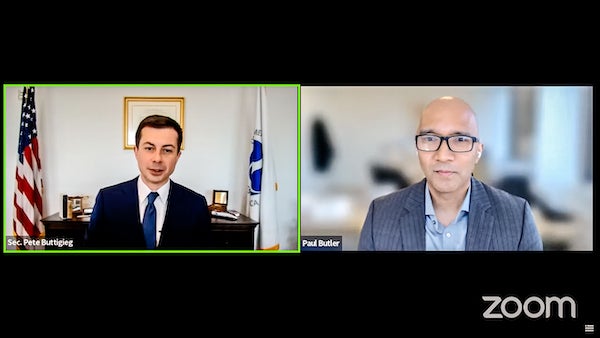This is what the current U.S. secretary of transportation thinks transit future might look like in 50 years: Flying cars. Drone delivery of packages. Net dividends on energy. Widespread acceptance of electric vehicles. And infrastructure that is more socially equitable.
“We have to make decisions that are a bit of a bet on the future, and at the same time, we don’t want to bet the farm on the future turning out one way or the other,” Pete Buttigieg said during an Arizona State University livestream event on Wednesday. “So what I spend a lot of time thinking about is how can we deploy our capital in an agile or nimble way so that some of these decisions will make sense, even if we don’t quite know how commuting patterns are going to work in seven years, let alone 50.”
Buttigieg joined ASU’s Future Tense for a conversation about infrastructure and imagination, which was followed by a discussion with three acclaimed science fiction authors — Linda Nagata, Annalee Newitz and Tochi Onyebuchi — about how they see their work inspiring visions of the future. Future Tense is a partnership of ASU, New America and Slate that examines emerging technologies, public policy and society. The goal of Wednesday’s discussion was to ask Buttigieg what role imagination plays in managing a federal department as sprawling and as impactful as the Department of Transportation, which he has headed since Feb. 3, 2021.
New America President Paul Butler moderated the wide-ranging 25-minute conversation with Buttigieg, who touched on transportation policies, priorities and how future mobility might look in a half-century. Buttigieg said he grew up watching “Star Trek” and noted that transportation, technology and imagination appear to be inextricably linked.
“It’s striking how much of our imagination about the future is centered on transportation, at least in terms of the imagery of it, right?” Buttigieg said. “You look at how the establishing shot of a sci-fi show or film, for example, tells you you’re in the future. There’s levitating cars or starships or something like that. … That’s what tells us we’re in the future.”
Secretary of Transportation Pete Buttigieg and New America Director Paul Butler discuss what role imagination plays in managing a federal department in an April 20 livestream event hosted by Arizona State University's Future Tense. Their conversation was followed by a discussion with three acclaimed science fiction authors — Linda Nagata, Annalee Newitz and Tochi Onyebuchi — about infrastructure and imagination.
Buttigieg said the most profound technologies that currently affect our lives are not necessarily vehicles or cars, but what what’s onboard these modes of transportation.
“One thing to consider is that in the last decade, I would argue the most important piece of transportation technology was not a vehicle — it was the smartphone,” he said. “The thing that changed transportation for most of us most tangibly was probably the rise of rideshare companies like Uber and Lyft. They were using the same kind of cars that taxis used and that we used to get ourselves around, but the way in which we would summon them changed. And through that, a different labor model emerged, a different means of getting around emerged, with good things and bad things that came out of it. … I think increasingly, you’re seeing automotive companies turning into software companies.”
Buttigieg concluded that America’s current infrastructure is about 150 years old and that President Joe Biden’s $1 trillion infrastructure bill to address those needs will be key to America’s future transit system. And so will smart decision-making.
“We know that we’re going to need resources and hubs where people can come together to access modes of transportation – things like train stations, town squares or transit hubs, airports and ports,” Buttigieg said. “So what we’ve got to do is invest in the things we know we’re going to need no matter what, and then create room for other things to happen that might be very difficult to picture. And the best way to do that is to not think about the asset first, but to think about the people that it’ll affect first.”
Buttigieg’s comments paved the way for a follow-up discussion with three Future Tense Fiction authors, led by Ed Finn, founding director of the Center for Science and the Imagination.
“Fiction has always been dear to my heart because I think it speaks to the heart of what we can do,” Finn said. “The future can inspire real change in the present and can invite people to imagine in detail these different possibilities.”
Transportation is a useful mechanism to transport — so to speak — readers to the future, all three authors agreed.
“It is interesting that we center vehicles so much in our fiction,” said Annalee Newitz, who writes about science, culture and the future. “I’m thinking about my novels, and all of them do start with transit. … But I find that a good way to take readers through the world.”
Newitz, who uses gender-neutral pronouns, said that when they started working on their 2021 book, “Four Lost Cities: A Secret History of the Urban Age,” an architect told them whenever Newitz visited a new city, take transit to the end of the line. They did that when visiting Istanbul, Turkey.
“I had an insane adventure on the train, which I found very valuable,” Newitz said. “It showed me all sorts of social relations. It showed me different neighborhoods. It showed me how well mass transit was maintained, which at that time was not super well.”
Writing about future transit is also nuanced and sometimes tricky, noted Onyebuchi.
“Sometimes the downside is that science fiction can be looked upon as some sort of predictive tool, right? ‘Oh, this is what it’s going to be like in the future,’” said Onyebuchi, a Nigerian American science fiction, fantasy writer and former civil rights lawyer. “Or there will be an evil company in a science fiction novel, and the lesson will be, ‘OK, don’t name your company after this evil company. Don’t be evil.'"
Science fiction should also be hopeful and optimistic whenever possible, Nagata belives.
“I’m at an age now where I’m really over the dystopia,” said Nagata, a Hawaiian-based author of speculative fiction, science fiction and fantasy novels, novellas and short stories. “I would like to still try to imagine that we do have a shot at a decent future.”
Top photo illustration courtesy iStock/Getty Images
More Law, journalism and politics

ASU experts share insights on gender equality across the globe
International Women’s Day has its roots in the American labor movement. In 1908, 15,000 women in New York City marched to protest against dangerous working conditions, better pay and the right to…

ASU Law to offer its JD part time and online, addressing critical legal shortages and public service
The Sandra Day O’Connor College of Law at Arizona State University, ranked 15th among the nation’s top public law schools, announced today a new part-time and fully online option for its juris doctor…

ASU launches nonpartisan Institute of Politics to inspire future public service leaders
Former Republican presidential nominee and Arizona native Barry Goldwater once wrote, "We have forgotten that a society progresses only to the extent that it produces leaders that are capable of…



